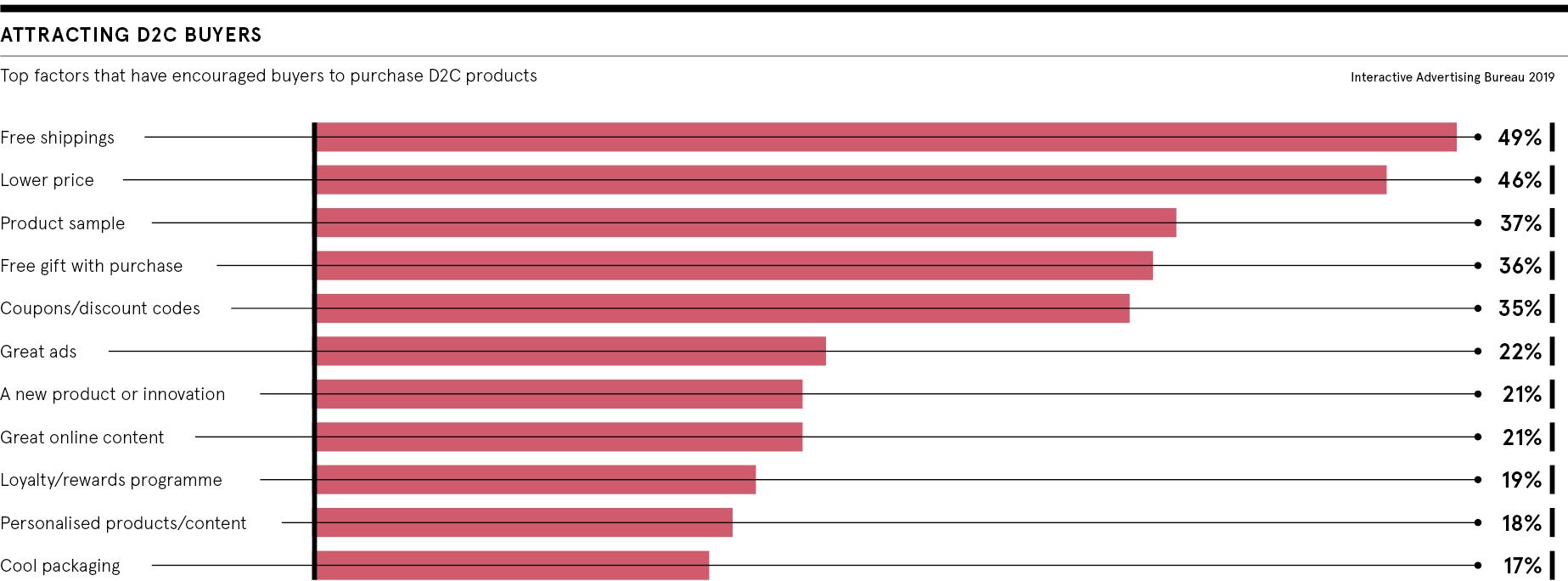Retail has had the equivalent of a coronary bypass in the last few months. The lifeblood of goods that flowed to consumers through the heart of the high street was cut off overnight. Savvy brands, ever-conscious of their commercial health, performed drastic surgery to avoid an economic bloodbath and went direct to the consumer.
Fuelled by images of empty shelves, a surge in home shopping and a need to access consumer-packaged goods, PepsiCo, Nestlé and Heinz all launched direct-to-consumer, or D2C, offerings in lockdown, appealing to those who couldn’t leave their home, but were dead set on their favourite ketchup or kombucha brand. They saw a huge opportunity to build loyalty simply by supplying goods to needy consumers online.
“Coronavirus triggered many brands to reassess their existing routes to market. As the world begins to return to some level of normality, it’ll be interesting to see which strategies become lasting changes and which are left by the wayside,” says Tim Bond, head of insight at the Data & Marketing Association.
That’s because this D2C model exploited a market failure: a lack of supply or a perception of one. But D2C ecommerce is not for the faint hearted. Amazon has made consumers expectant and impatient with their slick, quick and cost-effective deliveries. Bricks and mortar provide an easier route to market. With D2C there’s the logistics, technology platforms and payments, while dealing with the general public’s countless demands.

It’s also one thing to scale up a D2C offering quickly; it’s another to keep it fully operational, optimised and constantly changing in line with consumers’ expectations.
“The most significant challenge building a D2C model from scratch is economics. The cost of customer acquisition and bringing consumers online is initially expensive, although this gradually improves as an operation scales,” says Ali Holmes, senior ecommerce director at PepsiCo UK.
“To offset these economics, it’s been crucial to develop the right proposition to meet a specific consumer need and it needs to be supported by the right order value to make it viable.”
Bundling products together has helped in some cases, but what’s made it worthwhile, aside from better profit margins, is something consumer goods firms have wanted for a long time: customer data.
“Brands that rely on supermarkets, marketplaces and retailers to sell their products are at the mercy of these partners in feeding data back. D2C is the singular source of truth and a real insight for brands. This cannot be underestimated,” says Elliott Jacobs, director of commerce consulting at LiveArea.
D2C is all about the data
Newly hatched D2C brands are now creating their own databases, analysing behavioural and sales data to maximise marketing and profits. They are A/B testing – comparative user-experience research – new offers online and using their websites as labs for product research and development.
“This requires new skillsets for brands that historically haven’t owned their own customer data. The fact is data scientists are in demand and they aren’t cheap,” says Tom Roberts, chief executive of Tribal Worldwide London.
Companies thought they were successful due to branding and marketing. The truth is their supply chain strength carried them
The big question is whether this move to a D2C ecommerce model is here to stay. It’ll certainly become part of a multi-channel offering; whether it grows significantly is another matter. The internet is a crowded place and staying top of mind is a constant challenge. That’s why an in-store presence works. Digitally native brands are voracious competitors, since online is their primary channel. Marketplaces also dominate.
“For a long time, multinational companies deluded themselves thinking they were successful due to branding and marketing. The truth of the matter is their supply chain strength carried them through by making sure they were on the shelf of every store, everywhere. Now global brands need to find relevance again. They’ll need to reconnect with consumers once more, this time online,” says Maz Amirahmadi, chief executive of ABN Impact.
Bricks and mortar retail strikes back
However, let’s not forget, many D2C purchases during lockdown were substitutions because consumers couldn’t get to supermarkets. Traditional retail is on the way back and it’s more suited to consolidated shopping and product discovery. Those who have adopted D2C ecommerce to sell milk, coffee or other everyday products take note.
“The coronavirus crisis has created an amazing trial for D2C, but long-term success will go to the companies that provide outstanding value with quality products,” says David Mayer, senior partner for brand strategy at Lippincott.
The biggest shift recently is that it’s not only younger generations shopping online anymore, people of all ages have been forced to adopt new digital behaviours. This certainly favours the D2C model in the long run, but brands will need solid budgets and invest more to make it work.
“D2C itself doesn’t build brand affinity. The experience has to be good, the brand has to be relevant, the communications have to strike a chord. A lot has to be executed,” says Christian Polman, chief strategy officer at Ebiquity.
What the pandemic has taught many companies is D2C ecommerce isn’t just for smarter speciality startups that don’t want legacy retail and big overheads; it’s for all brands looking to drive preference, loyalty and repeat sales through a directly owned relationship.
“During the crisis, customers have also closely re-evaluated their consumption habits, what they define as essential products, as well as how to live better lives, even for the good of others. These values are now guiding customers towards brands that represent their own personal aspirations,” explains Michelle Du-Prât, group strategy director at Household.
There’s no doubt, habits and perceptions have changed, and new behaviours learnt. The general public certainly won’t forget this pandemic in a hurry.
“We believe there will be a ‘lockdown loyalty effect’. Consumers will remember the brands and retailers that got them through the darkest lockdown days,” Hugh Fletcher, global head of innovation at Wunderman Thompson Commerce concludes. Brands take note.

